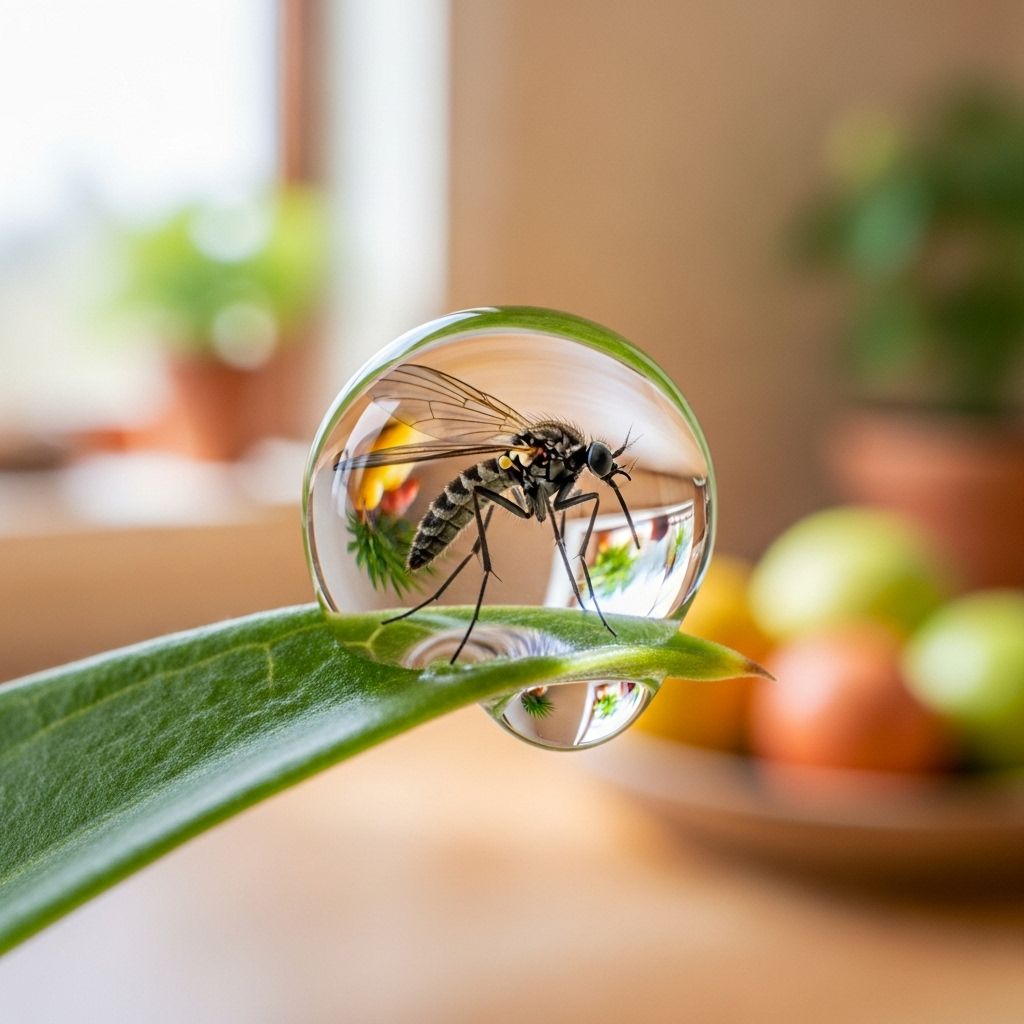How To Get Rid Of Gnats In Your Home: Comprehensive Guide
Banish gnats for good with expert tips on prevention, elimination, and control in every corner of your house.

Image: HearthJunction Design Team
How to Get Rid of Gnats in Your House, from Drains to Houseplants
Gnats are more than just a minor annoyance—they can infiltrate your kitchen, congregate around houseplants, and hover over drains, turning cozy living spaces into irritating battlegrounds. With their fondness for moist, organic matter and their rapid reproductive cycles, gnats can quickly become an unmanageable presence indoors, especially during the warm, humid months. In this guide, you’ll learn everything you need to know about identifying, eliminating, and preventing gnats in your home. We’ll cover causes, breeding grounds, and provide a toolkit of DIY and store-bought solutions so you can take back your space—effectively and safely.
Table of Contents
- What Are Gnats?
- Common Types of Gnats Found Indoors
- Where Do Gnats Come From?
- Signs of a Gnat Infestation
- Steps to Get Rid of Gnats
- DIY and Store-Bought Remedies
- How to Prevent Gnats
- Frequently Asked Questions (FAQs)
What Are Gnats?
Gnats are small flying insects that belong to several families of the order Diptera. While tiny, their presence indoors is noticeable—swarming over fruit bowls, congregating by windows, or spiraling above houseplants. Some species bite, while others are simply a nuisance.
Gnats thrive in moist, organic environments. They often breed in places with decaying plant material, saturated soil, clogged drains, and even within trash receptacles. Adult gnats lay their eggs in damp substrates, and larvae feed on fungi, plant roots, and decaying matter. Although most household gnats don’t bite, their rapid reproductive cycle can result in overwhelming numbers if not properly managed.
Common Types of Gnats Found Indoors
- Fungus Gnats: These are especially common in homes with houseplants. Fungus gnats lay their eggs in moist potting soil. The larvae feed on decaying organic matter and fungi in the soil, sometimes damaging delicate plant roots.
- Fruit Flies: While technically in a different family from true gnats, fruit flies are often grouped with them due to their similar size and behavior. They breed in overripe fruit, fermenting liquids, and food debris.
- Drain Flies: Also called sink flies or moth flies, these gnats breed in the organic sludge lining pipes and drains.
- Other Small Flies: Occasionally, you’ll see midges or phorid flies indoors, both of which are drawn to organic decay and moisture.
Where Do Gnats Come From?
Gnats are experts at finding the perfect breeding environment. Here’s where they commonly set up shop:
- Overwatered Houseplants: Consistently moist soil provides an ideal habitat for fungus gnats.
- Trash Cans: Leftover food residue and organic matter in garbage bins attract gnats looking to lay eggs.
- Sink Drains: Clogged or slow-moving drains with food sludge or biofilm are perfect breeding grounds for drain flies and gnats.
- Compost, Pet Waste, and Gutters: Any moist, decaying organic substrate can harbor gnat eggs and larvae.
In summary, anywhere there is a combination of moisture and something decomposable, gnats are likely to thrive.
Signs of a Gnat Infestation
- Seeing small, mosquito-like flies near soil, drains, fruit, or trash cans
- Swarms of tiny bugs when you disturb plants or garbage
- Wilting or yellowing plants (sometimes due to root damage from fungus gnat larvae)
- Persistent appearance of tiny flies after cleaning the area
Early detection is key to halting a minor gnat problem before it spirals into a full-blown infestation.
Steps to Get Rid of Gnats
Whether you’re dealing with a handful of gnats or a roomful, the fundamental principle is to target their breeding sources. As entomologist Emma Grace Crumbley advises, “No matter the kind of fly, the key to controlling a gnat infestation is to locate the breeding source and eliminate or reduce it as much as possible.”
1. Remove Attractants and Breeding Grounds
- Clean up all food debris and crumbs from counters and floors.
- Take out trash regularly—don’t let organic waste linger indoors.
- Empty and clean recycling bins, compost containers, and pet waste promptly.
- Keep drains free from sludge and organic build-up by using a brush or enzyme-based cleaner.
- Avoid overwatering houseplants. Let the soil dry out between waterings so it is inhospitable to fungus gnats.
2. Lower Water and Humidity Levels
- Fix leaky faucets and pipes to minimize unnecessary moisture.
- Use a dehumidifier or increase ventilation in damp areas like bathrooms and basements.
- Wipe down surfaces, including sinks and counters, to keep them dry.
3. Isolate and Treat Infested Houseplants
- Move infested plants away from healthy ones to prevent spread.
- Allow the top inch or two of soil to dry thoroughly between waterings.
- If infestation is severe, consider repotting the plant with fresh, sterile soil.
DIY and Store-Bought Remedies
Natural and Homemade Gnat Traps
- Apple Cider Vinegar Trap: Fill a small bowl with apple cider vinegar, a few drops of dish soap, and cover with plastic wrap. Poke small holes in the top—the scent attracts gnats, and the dish soap breaks the surface tension so they drown.
- Wine Trap: A shallow dish of red wine with dish soap works similarly to attract and trap gnats.
- Sticky Traps: Place yellow sticky cards near houseplants—fungus gnats are drawn to yellow and will get stuck on the card’s adhesive surface.
Store-Bought Solutions
- Gnat Sprays: Commercial sprays can kill adult gnats on contact. Look for options that are safe for indoor use and around pets and children.
- Larvicides for Soil: Biological controls, such as Bacillus thuringiensis israelensis (Bti), are harmless to plants and people but lethal to gnat larvae when sprinkled over the soil.
- Drain Cleaners: Enzyme-based drain cleaners break down organic material without harsh chemicals, reducing breeding sites in sinks and pipes.
Targeted Cleaning Techniques
- Scrub garbage cans and recycling bins with disinfectant.
- Flush sink drains with boiling water, or use a baking soda and vinegar mixture followed by hot water to dislodge biofilm.
- Remove decaying stems, leaves, and fruit from plant pots and countertops.
How to Prevent Gnats
Prevention is always more effective—and less frustrating—than dealing with a full infestation. Employ these best practices to keep gnats away for good:
- Avoid overwatering indoor plants. Let soil surfaces dry out before watering again.
- Never let food scraps or organic matter linger in trash bins or on counters.
- Regularly clean and disinfect garbage cans, drains, and recycling bins.
- Keep kitchens well-ventilated, and don’t allow damp sponges or towels to sit out.
- Ensure that windows and door screens are intact and free of tears to keep outdoor gnats from sneaking inside.
Summary Table: Gnat Control Strategies
| Trigger | Recommended Action |
|---|---|
| Overwatered Plants | Let soil dry out; use sticky traps or a biological larvicide |
| Trash Bins | Empty regularly; clean and disinfect weekly |
| Drain Build-up | Flush with boiling water; use enzyme cleaner |
| Pet Waste | Remove and dispose of waste daily |
| General Dampness | Use dehumidifiers; repair leaks promptly |
Frequently Asked Questions (FAQs)
Q: Are gnats harmful to humans or pets?
A: Most indoor gnats do not bite or sting. However, some outdoor biting gnats—like midges or no-see-ums—can cause mild irritation. Fungus gnats and fruit flies are simply a nuisance and do not harm humans or pets directly.
Q: How long do gnat infestations usually last?
A: With proper intervention, most indoor infestations can be brought under control within 1 to 2 weeks. However, if breeding sources are not addressed, the problem can persist indefinitely.
Q: What attracts gnats most in a typical household?
A: Standing water, moist soil, fruit and vegetable scraps, food residue in trash, and clogged drains are the main attractants for gnats indoors.
Q: Can gnats damage houseplants?
A: Yes, fungus gnat larvae can feed on fine plant roots, causing young or delicate houseplants to wilt, yellow, or even die if infestations are severe.
Q: Will chemical sprays alone solve the problem?
A: No. Sprays may kill adult gnats but will not address the eggs and larvae. Eliminating breeding media and moisture is essential for long-term control.
Final Thoughts
Gnats can be persistent, but with a combination of diligent cleaning, moisture management, and targeted remedies, you can reclaim your home and keep it pest-free. Pay special attention to the root causes—moisture and decaying organic matter—and you’ll nip future infestations in the bud before they take hold. For stubborn cases, consider consulting a pest control expert for professional advice and treatment options.
References
Read full bio of Shinta











